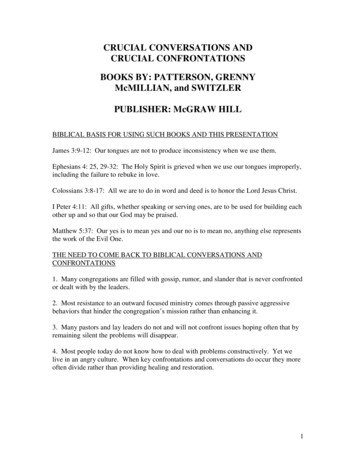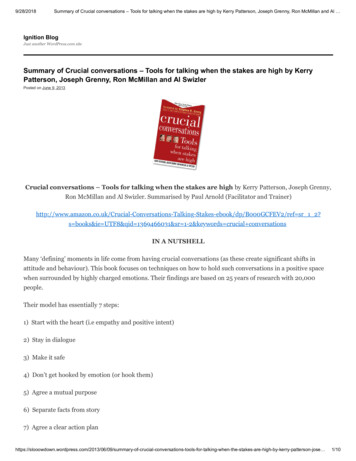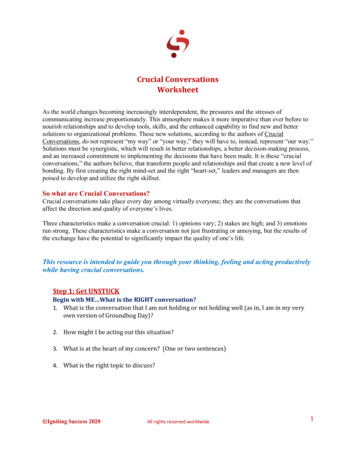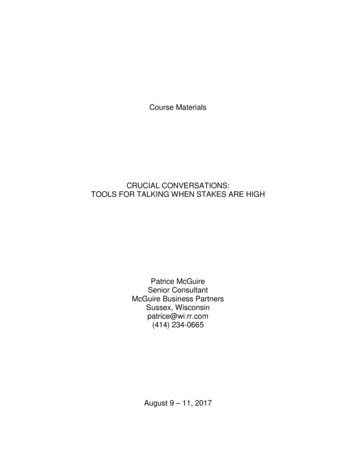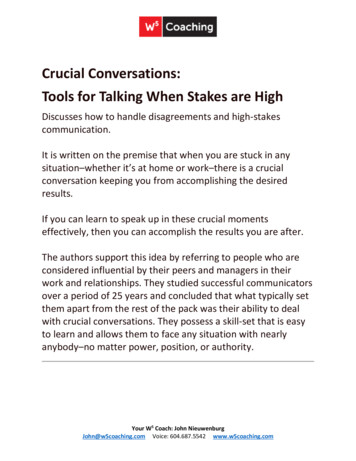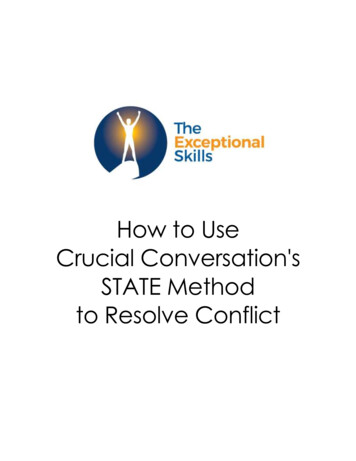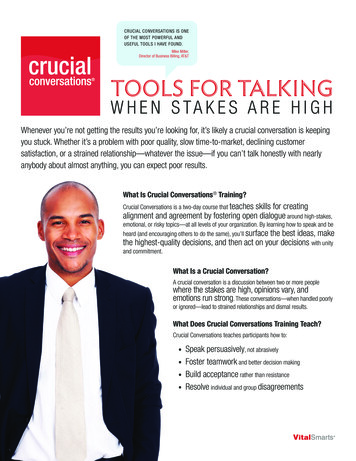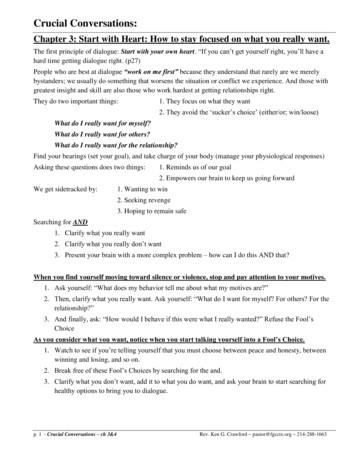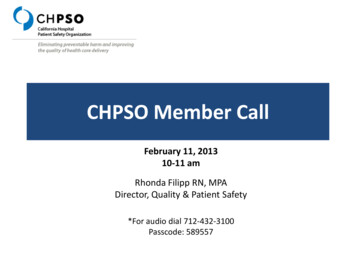
Transcription
CHPSO Member CallFebruary 11, 201310-11 amRhonda Filipp RN, MPADirector, Quality & Patient Safety*For audio dial 712-432-3100Passcode: 589557
January 2013Member Survey ResultsHave you established your Patient Safety EvaluationSystem (PSES)?ResponsePercent29.4%58.8%11.8%0.0%Answer OptionsYesNoI don't know.I do not know what defines a PSES.Have you established your Patient Safety EvaluationSystem (PSES)?YesNoI don't know.I do not know whatdefines a PSES.
January 2013Member Survey ResultsIf you answered "No" to the question above, what hasprevented you from establishing your PSES?Choose all answers that apply.Answer OptionsI do not know what steps to take to establish a PSES.I do not have the personnel or resources available to workon establishing a PSES.I do not have administrative or legal/risk managementsupport for establishing a PSES.Other (please specify) Response Percent28.6%14.3%0.0%57.1%Not seen as a priorityIn progressUnsure whose responsibility it is to set-up the PSESIf you answered "No" to the question above, what has preventedyou from establishing your PSES? Choose all answers that apply.I do not know what steps totake to establish a PSES.I do not have the personnelor resources available towork on establishing aPSES.I do not have administrativeor legal/risk managementsupport for establishing aPSES.Other (please specify)
January 2013Member Survey ResultsIf you have established a PSES, are you currentlysubmitting incident data to CHPSO/ECRI?Answer OptionsYesNoI don't knowResponsePercent14.3%71.4%14.3%If you have established a PSES, are you currently submitting incident data toCHPSO/ECRI?YesNoI don't know
January 2013Member Survey ResultsIf you answered "No" to the question above, what hasprevented you from submitting incident data toCHPSO/ECRI? Choose all that applyAnswer OptionsI do not know the process for sending data toCHPSO/ECRI.I do not have the personnel or resources availableto submit data to CHPSO/ECRI.Other (please specify)Responses to Other:1) In progress2) We have not established the PSESResponsePercent69.2%38.5%
CHPSO/ECRI Webinar:Patient Safety Evaluation System(PSES)Wednesday, February 13, 201310 am-11:30 am*PSO Basics presentation is posted onCHPSO/ECRI portal
Crucial Conversations inHealth CareFebruary 11, 2013Member Call
What is a crucial conversation?A discussion between 2 or more people where1) stakes are high2) opinions vary3) emotions run high
Why are they so difficult? We often learn from an early age to avoidconfronting people. We feel uncomfortable. We lack skill & confidence.
The impact of poorcommunication in health careThe Joint Commission identifies communicationas a root cause in 60% of sentinel events in their2012 report.
CHPSO data In the RCAs submitted for analysis by CHPSOmembers, communication issues wereidentified as a root cause or contributingfactor in 66% of events.
Other effects Low job satisfaction Decreased productivity Increased turnover Increased sick calls Low customer satisfaction patients families visitors
Study results 1700 respondents from 13 hospitals– Doctors, nurses, other clinicians, administrators– Teaching, general, and specialty hospitals Identified conversation categories that areespecially difficult, and at the same time,essential in health care– Teamwork– Performance/competence– Behavior
Study results 84 % physicians & 62% nurses & other clinicalcare providers witnessed co-workers takingshortcuts that could be dangerous to patients 1 in 5 physicians say they have seen harmcome to patients as a result of poorcommunication, teamwork, or performance 23% of nurses indicated that they areconsidering leaving their jobs because of theseconcerns
How often do we speak up? Only 1 in 10 respondents fully discussedconcerns with co-workers Most indicated it was between difficult &impossible to confront people in crucialsituations Much tougher to confront a physician, even byother physicians
Why don’t we speak up? We weigh the risk to benefit of having thisconversation– Fear of retaliation– Low confidence that it will make a difference orimprovement Belief that “it’s not my job” Lack of opportunity
Talking to others We may not bring it to the attention of theperson involved, but we often will speak toothers– 25% to 50% said they mentioned their concerns orfrustrations to other co-workers or the person’ssupervisor, not because they thought it would fix theproblem but to Create workarounds Warn others Blow off steam
Difficult Topics of Conversation Co-workers not following policies, guidelines, oraccepted practice Concerns over co-worker competence– poor clinical judgment– missing basic skills– making mistakes* Poor teamwork––––lack of support for co-workersdivisive behaviordisrespectbullying
Starting the conversationToo often we think we only have 2 options: Option 1: Speak up and turn this person into asworn enemyOR Option 2: Suffer in silence and make a baddecision that may put patients at riskAdd an Option 3: I can speak up AND maintain myrelationship with this person & protect my patients.
Starting the Conversation The environment must feel safe Conversation must be respectful– Ask yourself, “How can I be 100% honest & 100%respectful at the same time?” Stick to the facts– Reduces an emotional response Give the other person the opportunity toshare their view of the issues
When you disagree Listen– you probably agree more than you think Ground the conversation with the centralissue, not the specifics Point out where you agree Don’t tell the other person they are wrong;rather, point out where you differ
Benefits of speaking upThe 10% who address these crucial conversationsreport the following benefits more satisfied with their jobs better patient outcomes stronger relationships respected by peers & seen as top performers Improved communication, teamwork, and betteroutcomes increased patient satisfaction
Culture of SafetyHuge return on dproductivityIncreasedsatisfactionpatients, families,and staff
ResourcesSilence Kills: The Seven CrucialConversations for Healthcare
Build your skills Practice Develop a book club to review sections of thisor others books and practice with each other.– Sutter Health used Crucial Conversations forleadership training
Build your skills“The strategies and tools offered in Crucial Conversations wereinstrumental within our team. It broadened our ability to clarify importantconversations, check our own thoughts and responses in preparation ofthose important and most times difficult conversations, and gave us toolsto produce deliverables in a way that leaves both parties closer to a winwin outcome. It is an important read for healthcare leadership who havetough decisions to make, and deliver, in the months and years to come.”Teresa L. Wallace, MSW, CPHRM, CPHQSutter Health - Office of the General CounselDirector, Healthcare Risk
Positive feedback isimportant, tooDon’t forget the importance of expressing gratitudeand appreciation.“Silent gratitude isn’t much useto anyone.”-Gladys Bronwyn Stern
CHPSO/ECRI Webinar:Top 10 Health TechnologyHazards for 2013Wednesday, February 25, 201311:30 am-12:30 pm
EHR documentationsafety Promote reporting of EHR associated events– Examples: Addendum charting that resulted in error Results posted on the wrong patient’s chart Errors associated with PACS screen display
Next Member Call:Creating a Safe Journey for Patients:Maximizing Results of Your AHRQ Culture of Safety SurveySteven Savage, EdD, Quality Improvement Network Facilitator,California Hospital Engagement Network (CalHEN), California Hospital AssociationKassie Waters, Director, Quality ImprovementMarshall Medical Center in Placerville, CAMarch 11, 201310-11 am
The 10% who address these crucial conversations report the following benefits more satisfied with their jobs better patient outcomes stronger relationships respected by peers & seen as top performers
